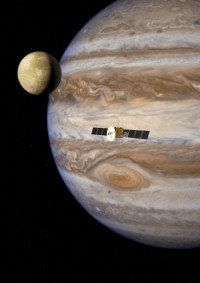The main science objectives for Jupiter's moons - Ganymede and to a lesser extent for Callisto, are:
- Characterisation of the ocean layers and detection of putative subsurface water reservoirs,
- Topographical, geological and compositional mapping of the surface,
- Study of the physical properties of the icy crusts,
- Characterisation of the internal mass distribution, dynamics and evolution of the interiors,
- Investigation of Ganymede's tenuous atmosphere,
- Study of Ganymede's intrinsic magnetic field and its interactions with the Jovian magnetosphere.

About Project
JUICE (JUpiter ICy moons Explorer) is European Space Agency (ESA) spacecraft designed to visit the Jovian system, focused on studying three of Jupiter's Galilean moons: Ganymede, Callisto, and Europa (excluding the more volcanically active Io). It will characterise these three worlds, all of which are thought to have significant bodies of liquid water beneath their surfaces, making them potentially habitable environments.
Scientific instruments
10 instruments were selected by ESA, which will be developed by scientific and engineering teams from all over Europe, with participation from the USA and Japan. The subsystems for two of them: a sub-millimeter wave instrument (SWI) and a radio plasma wave instrument (RPWI) are developed in Space Research Center of Polish Academy of Science:
- JANUS (Jovis, Amorum ac Natorum Undique Scrutator): camera system to image Ganymede and important parts of the surface of Callisto,
- MAJIS (Moons and Jupiter Imaging Spectrometer): a visible and infrared spectrometer for observations of tropospheric cloud features and minor species on Jupiter, it will investigate the composition of ices and minerals on the surfaces of icy moons,
- UVS (UV imaging Spectrograph): an imaging spectrograph that will characterise exospheres and aurorae of the icy moons,
- SWI (Sub-millimeter Wave Instrument): a spectrometer that will study Jupiter's stratosphere and troposphere, and the exospheres and surfaces of the icy moons,
- RPWI (Radio & Plasma Wave Investigation): will characterise the plasma environment and radio emissions around the spacecraft,
- GALA (GAnymede Laser Altimeter): a laser altimeter intended for studying topography of icy moons and tidal deformations of Ganymede,
- RIME (Radar for Icy Moons Exploration): an ice-penetrating radar to be used to study the subsurface structure of Jovian moons,
- J-MAG (A magnetometer for JUICE): the experiment will study subsurface oceans of the icy moons and the interaction of Jovian magnetic field with the magnetic field of Ganymede using a sensitive magnetometer,
- PEP (Particle Environment Package): will obtain the composition of the visited Jovian moons exospheres measuring density and fluxes of ions and neutral atoms ,
- 3GM (Gravity & Geophysics of Jupiter and Galilean Moons): radio experiment.
Launch in 2023
JUICE was launched on April 14, 2023 from French Guiana aboard an Ariane 5 carrier rocket and will arrive at the Jupiter system in 2031. By 2034 the spacecraft should enter orbit around Ganymede, after completing various manoeuvres around Jupiter and the other moons.